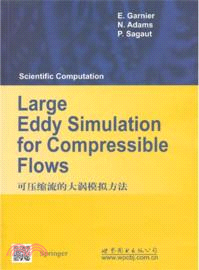相關商品
商品簡介
目次
商品簡介
可壓縮流的les是一個函待開發的領域,《可壓縮流的大渦模擬方法》旨在講述les基礎及其在實踐中的應用。為了最大程度地縮小理論框架之間的銜接,緩解les研究和日益增長的工程模型應用中的需求之間的矛盾,《可壓縮流的大渦模擬方法》最大程度地將和該領域有關論題囊括其中,用全新的方式全面講述了les理論及其應用。
目次
1 introduction
2 les governing equations
2.1 preliminary discussion
2.2 governing equations
2.2.1 fundamental assumptions
2.2.2 conservative formulation
2.2.3 alternative formulations
2.3 filtering operator
2.3.1 definition
2.3.2 discrete representation of filters
2.3.3 filtering of discontinuities
2.3.4 filter associated to the numerical method
2.3.5 commutation error
2.3.6 favre filtering
2.3.7 summary of the different type of filters
2.4 formulation of the filtered governing equations.
2.4.1 enthalpy formulation
2.4.2 temperature formulation
2.4.3 pressure formulation
2.4.4 entropy formulation
2.4.5 filtered total energy equations
2.4.6 momentum equations
2.4.7 simplifying assumptions
2.5 additional relations for les of compressible flows
2.5.1 preservation of original symmetries
2.5.2 discontinuity jump relations for les
2.5.3 second law of thermodynamics
2.6 model construction
2.6.1 basic hypothesis
2.6.2 modeling strategies
3 compressible turbulence dynamics
3.1 scope and content of this chapter
3.2 kovasznay decomposition of turbulent fluctuations
3.2.1 kovasznay's linear decomposition
3.2.2 weakly nonlinear kovasznay decomposition
3.3 statistical description of compressible turbulence
3.4 shock-turbulence interaction
3.4.1 introduction to the linear interaction approximation theory
3.4.2 vortical turbulence-shock interaction
3.4.3 mixed-mode turbulence-shock interaction
3.4.4 consequences for subgrid modeling
3.5 different regimes of isotropic compressible turbulence
3.5.1 quasi-isentropic-turbulence regime
3.5.2 nonlinear subsonic regime
3.5.3 supersonic regime
3.5.4 consequences for subgrid modeling
4 functional modeling
4.1 basis of functional modeling
4.1.1 phenomenology of scale interactions
4.1.2 basic functional modeling hypothesis
4.2 sgs viscosity
4.2.1 the boussinesq hypothesis
4.2.2 smagorinsky model
4.2.3 structure function model
4.2.4 mixed scale model
4.3 isotropic tensor modeling
4.4 sgs heat flux
4.5 modeling of the subgrid turbulent dissipation rate
4.6 improvement of sgs models
4.6.1 structural sensors and selective models
4.6.2 accentuation technique and filtered models
4.6.3 high-pass filtered eddy viscosity
4.6.4 wall-adapting local eddy-viscosity model
4.6.5 dynamic procedure
4.6.6 implicit diffusion and the implicit les concept
5 explicit structural modeling
5.1 motivation of structural modeling
5.2 models based on deconvolution
5.2.1 scale-similarity model
5.2.2 approximate deconvolution model
5.2.3 tensor-diffusivity model
5.3 regularization techniques;.
5.3.1 eddy-viscosity regularization
5.3.2 relaxation regularization
5.3.3 regularization by explicit filtering
5.4 multi-scale modeling of subgrid-scales
5.4.1 multi-level approaches
5.4.2 stretched-vortex model
5.4.3 variational multi-scale model
6 relation between sgs model and numerical discretization
6.1 systematic procedures for nonlinear error analysis
6.1.1 error sources
6.1.2 modified differential equation analysis
6.1.3 modified differential equation analysis in spectral space
6.2 implicit les approaches based on linear and nonlinear discretization schemes
6.2.1 the volume balance procedure of schumamm
6.2.2 the kawamura-kuwahara scheme
6.2.3 the piecewise-parabolic method
6.2.4 the flux-corrected-transport method
6.2.5 the mpdata method
6.2.6 the optimum finite-volume scheme
6.3 implicit les by adaptive local deconvolution
6.3.1 fundamental concept of aldm
6.3.2 aldm for the incompressible navier-stokes equations.
6.3.3 aldm for the compressible navier-stokes equations
7 boundary conditions for large-eddy simulation of compressible flows
7.1 introduction
7.2 wall modeling for compressible les
7.2.1 statement of the problem
7.2.2 wall boundary conditions in the kovasznay decomposition framework: an insight
7.2.3 turbulent boundary layer: vorticity and temperature fields
7.2.4 turbulent boundary layer: acoustic field
7.2.5 consequences for the development of compressible wall models
7.2.6 extension of existing wall models for incompressible flows
7.3 unsteady turbulent inflow conditions for compressible les
7.3.1 fundamentals
7.3.2 precursor simulation: advantages and drawbacks
7.3.3 extraction-rescaling techniques
7.3.4 synthetic-turbulence-based models
8 subsonic applications with compressibility effects
8.1 homogeneous turbulence
8.1.1 context
8.1.2 a few realizations
8.1.3 influence of the numerical method
8.1.4 sgs modeling
8.2 channel flow
8.2.1 context
8.2.2 a few realizations
8.2.3 influence of the numerical method
8.2.4 influence of the sgs model
8.3 mixing layer
8.3.1 context
8.3.2 a few realizations
8.3.3 influence of the numerical method
8.3.4 influence of the sgs model
8.4 boundary-layer flow
8.4.1 context
8.4.2 a few realizations
8.5 jets
8.5.1 context
8.5.2 a few realizations
8.5.3 influence of the numerical method
8.5.4 influence of the sgs model
8.5.5 physical analysis
8.6 flows over cavities
8.6:1 context
8.6.2 a few realizations
8.6.3 influence of the numerical method
8.6.4 influence of the sgs model
8.6.5 physical analysis
9 supersonic applications
9.1 homogeneous turbulence
9.2 channel flow
9.2.1 context
9.2.2 a few realizations
9.2.3 influence of the numerical method
9.2.4 influence of the grid resolution
9.2.5 influence of the sgs model
9.3 boundary layers
9.3.1 context
9.3.2 a few realizations
9.3.3 influence of the numerical method
9.3.4 influence of the grid resolution
9.3.5 sgs modeling
9.4 jets
9.4.1 context
9.4.2 a few realizations
9.4.3 influence of the numerical method
9.4.4 influence of the sgs model
9.4.5 physical analysis
10 supersonic applications with shock-turbulence interaction
10.1 shock-interaction with homogeneous turbulence
10.1.1 phenomenology of shock-interaction with homogeneous turbulence
10.1.2 les of shock-interaction with homogeneous turbulence
10.2 shock-turbulence interaction in jets
10.2.1 phenomenology of shock-turbulence interaction in jets
10.2.2 les of shock-turbulence interaction in jets
10.3 shock-turbulent-boundary-layer interaction
10.3.1 phenomenology of shock-turbulent-boundary-layer interaction
10.3.2 les of compression-ramp configurations
references
index
2 les governing equations
2.1 preliminary discussion
2.2 governing equations
2.2.1 fundamental assumptions
2.2.2 conservative formulation
2.2.3 alternative formulations
2.3 filtering operator
2.3.1 definition
2.3.2 discrete representation of filters
2.3.3 filtering of discontinuities
2.3.4 filter associated to the numerical method
2.3.5 commutation error
2.3.6 favre filtering
2.3.7 summary of the different type of filters
2.4 formulation of the filtered governing equations.
2.4.1 enthalpy formulation
2.4.2 temperature formulation
2.4.3 pressure formulation
2.4.4 entropy formulation
2.4.5 filtered total energy equations
2.4.6 momentum equations
2.4.7 simplifying assumptions
2.5 additional relations for les of compressible flows
2.5.1 preservation of original symmetries
2.5.2 discontinuity jump relations for les
2.5.3 second law of thermodynamics
2.6 model construction
2.6.1 basic hypothesis
2.6.2 modeling strategies
3 compressible turbulence dynamics
3.1 scope and content of this chapter
3.2 kovasznay decomposition of turbulent fluctuations
3.2.1 kovasznay's linear decomposition
3.2.2 weakly nonlinear kovasznay decomposition
3.3 statistical description of compressible turbulence
3.4 shock-turbulence interaction
3.4.1 introduction to the linear interaction approximation theory
3.4.2 vortical turbulence-shock interaction
3.4.3 mixed-mode turbulence-shock interaction
3.4.4 consequences for subgrid modeling
3.5 different regimes of isotropic compressible turbulence
3.5.1 quasi-isentropic-turbulence regime
3.5.2 nonlinear subsonic regime
3.5.3 supersonic regime
3.5.4 consequences for subgrid modeling
4 functional modeling
4.1 basis of functional modeling
4.1.1 phenomenology of scale interactions
4.1.2 basic functional modeling hypothesis
4.2 sgs viscosity
4.2.1 the boussinesq hypothesis
4.2.2 smagorinsky model
4.2.3 structure function model
4.2.4 mixed scale model
4.3 isotropic tensor modeling
4.4 sgs heat flux
4.5 modeling of the subgrid turbulent dissipation rate
4.6 improvement of sgs models
4.6.1 structural sensors and selective models
4.6.2 accentuation technique and filtered models
4.6.3 high-pass filtered eddy viscosity
4.6.4 wall-adapting local eddy-viscosity model
4.6.5 dynamic procedure
4.6.6 implicit diffusion and the implicit les concept
5 explicit structural modeling
5.1 motivation of structural modeling
5.2 models based on deconvolution
5.2.1 scale-similarity model
5.2.2 approximate deconvolution model
5.2.3 tensor-diffusivity model
5.3 regularization techniques;.
5.3.1 eddy-viscosity regularization
5.3.2 relaxation regularization
5.3.3 regularization by explicit filtering
5.4 multi-scale modeling of subgrid-scales
5.4.1 multi-level approaches
5.4.2 stretched-vortex model
5.4.3 variational multi-scale model
6 relation between sgs model and numerical discretization
6.1 systematic procedures for nonlinear error analysis
6.1.1 error sources
6.1.2 modified differential equation analysis
6.1.3 modified differential equation analysis in spectral space
6.2 implicit les approaches based on linear and nonlinear discretization schemes
6.2.1 the volume balance procedure of schumamm
6.2.2 the kawamura-kuwahara scheme
6.2.3 the piecewise-parabolic method
6.2.4 the flux-corrected-transport method
6.2.5 the mpdata method
6.2.6 the optimum finite-volume scheme
6.3 implicit les by adaptive local deconvolution
6.3.1 fundamental concept of aldm
6.3.2 aldm for the incompressible navier-stokes equations.
6.3.3 aldm for the compressible navier-stokes equations
7 boundary conditions for large-eddy simulation of compressible flows
7.1 introduction
7.2 wall modeling for compressible les
7.2.1 statement of the problem
7.2.2 wall boundary conditions in the kovasznay decomposition framework: an insight
7.2.3 turbulent boundary layer: vorticity and temperature fields
7.2.4 turbulent boundary layer: acoustic field
7.2.5 consequences for the development of compressible wall models
7.2.6 extension of existing wall models for incompressible flows
7.3 unsteady turbulent inflow conditions for compressible les
7.3.1 fundamentals
7.3.2 precursor simulation: advantages and drawbacks
7.3.3 extraction-rescaling techniques
7.3.4 synthetic-turbulence-based models
8 subsonic applications with compressibility effects
8.1 homogeneous turbulence
8.1.1 context
8.1.2 a few realizations
8.1.3 influence of the numerical method
8.1.4 sgs modeling
8.2 channel flow
8.2.1 context
8.2.2 a few realizations
8.2.3 influence of the numerical method
8.2.4 influence of the sgs model
8.3 mixing layer
8.3.1 context
8.3.2 a few realizations
8.3.3 influence of the numerical method
8.3.4 influence of the sgs model
8.4 boundary-layer flow
8.4.1 context
8.4.2 a few realizations
8.5 jets
8.5.1 context
8.5.2 a few realizations
8.5.3 influence of the numerical method
8.5.4 influence of the sgs model
8.5.5 physical analysis
8.6 flows over cavities
8.6:1 context
8.6.2 a few realizations
8.6.3 influence of the numerical method
8.6.4 influence of the sgs model
8.6.5 physical analysis
9 supersonic applications
9.1 homogeneous turbulence
9.2 channel flow
9.2.1 context
9.2.2 a few realizations
9.2.3 influence of the numerical method
9.2.4 influence of the grid resolution
9.2.5 influence of the sgs model
9.3 boundary layers
9.3.1 context
9.3.2 a few realizations
9.3.3 influence of the numerical method
9.3.4 influence of the grid resolution
9.3.5 sgs modeling
9.4 jets
9.4.1 context
9.4.2 a few realizations
9.4.3 influence of the numerical method
9.4.4 influence of the sgs model
9.4.5 physical analysis
10 supersonic applications with shock-turbulence interaction
10.1 shock-interaction with homogeneous turbulence
10.1.1 phenomenology of shock-interaction with homogeneous turbulence
10.1.2 les of shock-interaction with homogeneous turbulence
10.2 shock-turbulence interaction in jets
10.2.1 phenomenology of shock-turbulence interaction in jets
10.2.2 les of shock-turbulence interaction in jets
10.3 shock-turbulent-boundary-layer interaction
10.3.1 phenomenology of shock-turbulent-boundary-layer interaction
10.3.2 les of compression-ramp configurations
references
index
主題書展
更多
主題書展
更多書展本週66折
您曾經瀏覽過的商品
購物須知
大陸出版品因裝訂品質及貨運條件與台灣出版品落差甚大,除封面破損、內頁脫落等較嚴重的狀態,其餘商品將正常出貨。
特別提醒:部分書籍附贈之內容(如音頻mp3或影片dvd等)已無實體光碟提供,需以QR CODE 連結至當地網站註冊“並通過驗證程序”,方可下載使用。
無現貨庫存之簡體書,將向海外調貨:
海外有庫存之書籍,等候約45個工作天;
海外無庫存之書籍,平均作業時間約60個工作天,然不保證確定可調到貨,尚請見諒。
為了保護您的權益,「三民網路書店」提供會員七日商品鑑賞期(收到商品為起始日)。
若要辦理退貨,請在商品鑑賞期內寄回,且商品必須是全新狀態與完整包裝(商品、附件、發票、隨貨贈品等)否則恕不接受退貨。
























